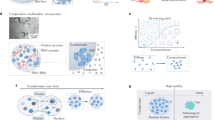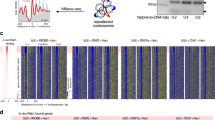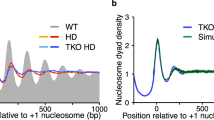Abstract
Nucleosome positioning is critical for gene expression and most DNA-related processes. Here we review the dominant patterns of nucleosome positioning that have been observed and summarize the current understanding of their underlying determinants. The genome-wide pattern of nucleosome positioning is determined by the combination of DNA sequence, ATP-dependent nucleosome remodeling enzymes and transcription factors that include activators, components of the preinitiation complex and elongating RNA polymerase II. These determinants influence each other such that the resulting nucleosome positioning patterns are likely to differ among genes and among cells in a population, with consequent effects on gene expression.
This is a preview of subscription content, access via your institution
Access options
Subscribe to this journal
Receive 12 print issues and online access
$189.00 per year
only $15.75 per issue
Buy this article
- Purchase on Springer Link
- Instant access to full article PDF
Prices may be subject to local taxes which are calculated during checkout



Similar content being viewed by others
References
Richmond, T.J. & Davey, C.A. The structure of DNA in the nucleosome core. Nature 423, 145–150 (2003).
Yuan, G.-C. et al. Genome-scale identification of nucleosome positions in S. cerevisiae. Science 309, 626–630 (2005).
Lee, W. et al. A high-resolution atlas of nucleosome occupancy in yeast. Nat. Genet. 39, 1235–1244 (2007).
Mavrich, T.N. et al. A barrier nucleosome model for statistical positioning of nucleosome throughout the yeast genome. Genome Res. 18, 1073–1083 (2008).
Mavrich, T.N. et al. Nucleosome organization in the Drosophila genome. Nature 453, 358–362 (2008).
Schones, D.E. et al. Dynamic regulation of nucleosome positioning in the human genome. Cell 132, 887–898 (2008).
Shivaswamy, S. et al. Dynamic remodeling of individual nucleosomes across a eukaryotic genome in response to transcriptional perturbation. PLoS Biol. 6, e65 (2008).
Valouev, A. et al. A high-resolution, nucleosome position map of C. elegans reveals a lack of universal sequence-dictated positioning. Genome Res. 18, 1051–1063 (2008).
Valouev, A. et al. Determinants of nucleosome organization in primary human cells. Nature 474, 516–520 (2011).
Freidkin, I. & Katcoff, D.J. Specific distribution of the Saccharomyces cerevisiae linker histone HHO1 in the chromatin. Nucleic Acids Res. 29, 4043–4051 (2001).
Lam, F.H., Steger, D.J. & O'Shea, E.K. Chromatin decouples promoter threshold from dynamic range. Nature 453, 246–250 (2008).
Raveh-Sadka, T. et al. Manipulating nucleosome disfavoring sequences allows fine-tune regulation of gene expression in yeast. Nat. Genet. 44, 743–750 (2012).
Varshavsky, A.J., Sundin, O. & Bohn, M. A stretch of “late” SV40 viral DNA about 400 bp long which induces the origin of replication is specifically exposed in SV40 minichromosomes. Cell 16, 453–466 (1979).
Wu, C. The 5′ ends of Drosophila heat shock genes in chromatin are hypersensitive to DNase I. Nature 286, 854–860 (1980).
Iyer, V. & Struhl, K. Poly(dA:dT), a ubiquitous promoter element that stimulates transcription via its intrinsic structure. EMBO J. 14, 2570–2579 (1995).
Liu, X., Lee, C.K., Granek, J.A., Clarke, N.D. & Lieb, J.D. Whole-genome comparison of Leu3 binding in vitro and in vivo reveals the importance of nucleosome occupancy in target site selection. Genome Res. 16, 1517–1528 (2006).
Zaret, K.S. & Carroll, J.S. Pioneer transcription factors: establishing competence for gene expression. Genes Dev. 25, 2227–2241 (2011).
Workman, J.L. & Kingston, R.E. Alteration of nucleosome structure as a mechanism of transcriptional regulation. Annu. Rev. Biochem. 67, 545–579 (1998).
Thastrom, A. et al. Sequence motifs and free energies of selected natural and non-natural nucleosome positioning DNA sequences. J. Mol. Biol. 288, 213–229 (1999).
Drew, H.R. & Travers, A.A. DNA bending and its relation to nucleosome positioning. J. Mol. Biol. 186, 773–790 (1985).
Satchwell, S.C., Drew, H.R. & Travers, A.A. Sequence periodicities in chicken nucleosome core DNA. J. Mol. Biol. 191, 659–675 (1986).
Segal, E. et al. A genomic code for nucleosome positioning. Nature 442, 772–778 (2006).
Brogaard, K.R., Xi, L., Wang, J.P. & Widom, J. A map of nucleosome positions in yeast at base-pair resolution. Nature 486, 496–501 (2012).
Nelson, H.C.M., Finch, J.T., Luisi, B.F. & Klug, A. The structure of an oligo(dA)·oligo(dT) tract and its biological implications. Nature 330, 221–226 (1987).
Suter, B., Schnappauf, G. & Thoma, F. Poly(dA-dT) sequences exist as rigid DNA structures in nucleosome-free yeast promoters in vivo. Nucleic Acids Res. 28, 4083–4089 (2000).
Segal, E. & Widom, J. Poly(dA:dT) tracts: major determinants of nucleosome organization. Curr. Opin. Struct. Biol. 19, 65–71 (2009).
McCall, M., Brown, T. & Kennard, O. The crystal structure of d(G-G-G-G-C-C-C-C): a model for poly(dG)·poly(dC). J. Mol. Biol. 183, 385–396 (1985).
Dechering, K.J., Cuelenaere, K., Konings, R.N. & Leunissen, J.A. Distinct frequency-distributions of homopolymeric DNA tracts in different genomes. Nucleic Acids Res. 26, 4056–4062 (1998).
Struhl, K. Naturally occurring poly(dA-dT) sequences are upstream promoter elements for constitutive transcription in yeast. Proc. Natl. Acad. Sci. USA 82, 8419–8423 (1985).
Field, Y. et al. Distinct modes of regulation by chromatin encoded through nucleosome positioning signals. PLoS Comput. Biol. 4, e1000216 (2008).
Gaffney, D.J. et al. Controls of nucleosome positioning in the human genome. PLoS Genet. 8, e1003036 (2012).
Kaplan, N. et al. The DNA-encoded nucleosome organization of a eukaryotic genome. Nature 458, 362–366 (2009).
Zhang, Y. et al. Intrinsic histone-DNA interactions are not the major determinant of nucleosome positions in vivo. Nat. Struct. Mol. Biol. 16, 847–852 (2009).
Sekinger, E.A., Moqtaderi, Z. & Struhl, K. Intrinsic histone-DNA interactions and low nucleosome density are important for preferential accessibility of promoter regions in yeast. Mol. Cell 18, 735–748 (2005).
Hughes, A., Jin, Y., Rando, O.J. & Struhl, K. A functional evolutionary approach to identify determinants of nucleosome positioning: a unifying model for establishing the genome-wide pattern. Mol. Cell 48, 5–15 (2012).
Chen, W., Tabor, S. & Struhl, K. Distinguishing between mechanisms of eukaryotic transcriptional activation with bacteriophage T7 RNA polymerase. Cell 50, 1047–1055 (1987).
Zhu, Z. & Thiele, D.J. A specialized nucleosome modulates transcription factor access to a C. glabrata metal responsive promoter. Cell 87, 459–470 (1996).
Zeevi, D. et al. Compensation for differences in gene copy number among yeast ribosomal proteins is encoded within their promoters. Genome Res. 21, 2114–2128 (2011).
Field, Y. et al. Gene expression divergence in yeast is coupled to evolution of DNA-encoded nucleosome organization. Nat. Genet. 41, 438–445 (2009).
Tirosh, I. & Barkai, N. Two strategies for gene regulation by promoter nucleosomes. Genome Res. 18, 1084–1091 (2008).
Fan, X. et al. Nucleosome depletion in yeast terminator regions is not intrinsic and can occur by a transcriptional mechanism linked to 3′ end formation. Proc. Natl. Acad. Sci. USA 107, 17945–17950 (2010).
Lantermann, A.B. et al. Schizosaccharomyces pombe gene-wide nucleosome mapping reveals positioning mechanisms distinct from those of Saccharomyces cerevisiae. Nat. Struct. Mol. Biol. 17, 251–257 (2010).
Tsankov, A.M., Thompson, D.A., Socha, A., Regev, A. & Rando, O.J. The role of nucleosome positioning in the evolution of gene regulation. PLoS Biol. 8, e1000414 (2010).
Tsankov, A., Yanagisawa, Y., Rhind, N., Regev, A. & Rando, O.J. Evolutionary divergence of intrinsic and trans-regulated nucleosome positioning sequences reveals plastic rules for chromatin organization. Genome Res. 21, 1851–1862 (2011).
Zhang, Z. et al. A packing mechanism for nucleosome organization reconstituted across a eukaryotic genome. Science 332, 977–980 (2011).
Wippo, C.J. et al. The RSC chromatin remodelling enzyme has a unique role in directing the accurate positioning of nucleosomes. EMBO J. 30, 1277–1288 (2011).
Badis, G. et al. A library of yeast transcription factor motifs reveals a widespread function for Rsc3 in targeting nucleosome exclusion at promoters. Mol. Cell 32, 878–887 (2008).
Floer, M. et al. A RSC/nucleosome complex determines chromatin architecture and facilitates activator binding. Cell 141, 407–418 (2010).
Rippe, K. et al. DNA sequence- and conformation-directed positioning of nucleosomes by chromatin-remodeling complexes. Proc. Natl. Acad. Sci. USA 104, 15635–15640 (2007).
van Vugt, J.J. et al. Multiple aspects of ATP-dependent nucleosome translocation by RSC and Mi-2 are directed by the underlying DNA sequence. PLoS ONE 4, e6345 (2009).
Whitehouse, I. & Tsukiyama, T. Antagonistic forces that position nucleosomes in vivo. Nat. Struct. Mol. Biol. 13, 633–640 (2006).
Whitehouse, I., Rando, O.J., Delrow, J. & Tsukiyama, T. Chromatin remodelling at promoters suppresses antisense transcription. Nature 450, 1031–1035 (2007).
Hartley, P.D. & Madhani, H.D. Mechanisms that specify promoter nucleosome location and identity. Cell 137, 445–458 (2009).
Gkikopoulos, T. et al. A role for Snf2-related nucleosome-spacing enzymes in genome-wide nucleosome organization. Science 333, 1758–1760 (2011).
Hennig, B.P., Bendrin, K., Zhou, Y. & Fischer, T. Chd1 chromatin remodelers maintain nucleosome organization and repress cryptic transcription. EMBO Rep. 13, 997–1003 (2012).
Pointner, J. et al. CHD1 remodelers regulate nucleosome spacing in vitro and align nucleosomal arrays over gene coding regions in S. pombe. EMBO J. 31, 4388–4403 (2012).
Shim, Y.S. et al. Hrp3 controls nucleosome positioning to suppress non-coding transcription in eu- and heterochromatin. EMBO J. 31, 4375–4387 (2012).
Celona, B. et al. Substantial histone reduction modulates genomewide nucleosomal occupancy and global transcriptional output. PLoS Biol. 9, e1001086 (2011).
Gossett, A.J. & Lieb, J.D. In vivo effects of histone H3 depletion on nucleosome occupancy and position in Saccharomyces cerevisiae. PLoS Genet. 8, e1002771 (2012).
Ito, T., Bulger, M., Pazin, M.J., Kobayashi, R. & Kadonaga, J.T. ACF, an ISW1-containing and ATP-utilizing chromatin assembly and remodeling factor. Cell 90, 145–155 (1997).
Drew, H.R. Reconstitution of short-spaced chromatin from the histone octamer and either HMG14,17 or histone H1. J. Mol. Biol. 230, 824–836 (1993).
Fan, Y. et al. Histone H1 depletion in mammals alters global chromatin structure but causes specific changes in gene regulation. Cell 123, 1199–1212 (2005).
Hashimoto, H. et al. Histone H1 null vertebrate cells exhibit altered nucleosome architecture. Nucleic Acids Res. 38, 3533–3545 (2010).
Oberg, C., Izzo, A., Schneider, R., Wrange, O. & Belikov, S. Linker histone subtypes differ in their effect on nucleosome spacing in vivo. J. Mol. Biol. 419, 183–197 (2012).
Rhee, H.S. & Pugh, B.F. Genome-wide structure and organization of eukaryotic pre-initiation complexes. Nature 483, 295–301 (2012).
Adelman, K. & Lis, J.T. Promoter-proximal pausing of RNA polymerase II: emerging roles in metazoans. Nat. Rev. Genet. 13, 720–731 (2012).
Chang, G.S. et al. Unusual combinatorial involvement of poly-A/T tracts in organizing genes and chromatin in Dictyostelium. Genome Res. 22, 1098–1106 (2012).
Vaillant, C. et al. A novel strategy of transcription regulation by intragenic nucleosome ordering. Genome Res. 20, 59–67 (2010).
Yen, K., Vinayachandran, V., Batta, K., Koerber, R.T. & Pugh, B.F. Genome-wide nucleosome specificity and directionality of chromatin remodelers. Cell 149, 1461–1473 (2012).
Acknowledgements
This Review is dedicated to the memory of Jon Widom, our dear friend and colleague, who is sorely missed by the authors and the scientific community. We thank D. Schneider for encouraging us to write this Review, and Z. Moqtaderi, T. Raveh-Sadka, M. Levo, N. Kaplan and Y. Field for comments on the manuscript. This work was supported by grant GM 30186 from the US National Institutes of Health to K.S. and grants from the European Research Council and the US National Institutes of Health to E.S.
Author information
Authors and Affiliations
Corresponding authors
Ethics declarations
Competing interests
The authors declare no competing financial interests.
Rights and permissions
About this article
Cite this article
Struhl, K., Segal, E. Determinants of nucleosome positioning. Nat Struct Mol Biol 20, 267–273 (2013). https://doi.org/10.1038/nsmb.2506
Received:
Accepted:
Published:
Issue Date:
DOI: https://doi.org/10.1038/nsmb.2506
This article is cited by
-
A complex network of transcription factors and epigenetic regulators involved in bovine leukemia virus transcriptional regulation
Retrovirology (2023)
-
Transcription and FACT facilitate the restoration of replication-coupled chromatin assembly defects
Scientific Reports (2023)
-
Ageing-associated changes in transcriptional elongation influence longevity
Nature (2023)
-
Dynamic nucleosome landscape elicits a noncanonical GATA2 pioneer model
Nature Communications (2022)
-
Nucleosome-directed replication origin licensing independent of a consensus DNA sequence
Nature Communications (2022)



